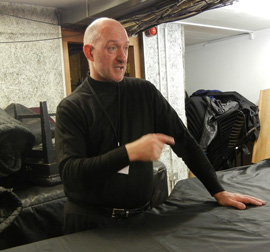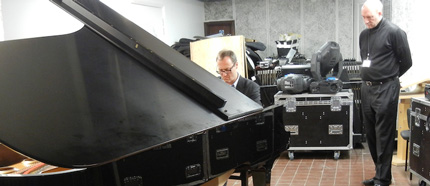Master Technician Peter Salisbury on Piano Sound and the Magic Ingredient in Quality Grands
During a recent visit to South Bank Centre in London to find out more about “double action” pianos, Piano Street’s Patrick Jovell had a chance to speak with the in-house piano technician Peter Salisbury. He has worked with almost every famous international concert pianist who has played in London over the last 20 years and in this article he shares his thoughts about the current situation on the concert grand piano market.
PJ: You are not only working with the instruments here at London’s South Bank Centre, but you are also traveling the world with your expertise, right?

Piano technician Peter Salisbury
PS: Here at the South Bank Centre, we are able to cultivate instruments in an extraordinary way. I follow each instrument closely. It is quite a long process, actually. The journey takes an instrument from the factory, where it has a blank, standard voicing, through an extreme amount of daily adjustment and care. I have to tinker with all the instruments until I know which instrument to pair with which performer. I also have to determine which piano will work best with which repertoire. Finally, I must also consider the hall where a specific performance is to take place. For instance, when I go to Singapore every few months, I have to adjust the instruments because a lot has happened to them in the interim. It usually takes me three years to get an instrument to an optimal point that displays its full potential. There are only a few in our select fraternity. We travel the world optimising concert instruments at the highest possible level. The industry as a whole, by and large, does not appreciate our work. It does not capture their imagination. I am thoroughly grateful to this place, though. It gives me the chance to excel, and almost no other place gives me the funding that I enjoy here. One of my colleagues, Thomas Hubst, enjoys the same respect and funding in Berlin, however. I am also grateful that he and I can operate in a similar way.
PJ: You have worked closely with the chief technicians of Steinway, Bösendorfer, Bechstein, Yamaha and Fazioli. Which ideas do you have on instrument brands?
PS: There are only good and bad instruments, and the gladiatorial battle between brands is really both naive and ridiculous. It is akin to saying Schubert is better than Chopin! The argument is useless. One should look for that magic ingredient in every piano, regardless of its brand. I have heard that magic quality in Bösendorfers, Steinways, Faziolis, and Yamahas. Therefore, I think this Steinway dominance is not good for the environment. By 1914, there were many other instruments extant. There existed a variety of sound concepts and ways of playing different instruments. I am a fan of individuality in musical expression and concept, so I want to prevent Steinway from totally diluting the environment.
When I was caring for the instruments at the Royal Academy of Music here in London, they took a very bold step. They wanted to change their piano stock and purchased 70 percent Steinway, 20 percent Bösendorfer, and 10 percent Fazioli and Yamaha. This reflected the same percentages one would encounter in concert arenas around the world. The Royal Academy could then have one Steinway and one Bösendorfer in a teaching room. I thought this was quite intelligent! Pianists could try different instruments and switch between them after evaluating what was working or not working. This is an incredible education for the ear and preparation for the future. I am, therefore, in favour of the “school of all brands.” Supporting only one brand would foster a system that bred performance robots. Everybody and everything would sound the same.
PJ: Here in the basement under Queen Elisabeth Hall, you have let me try a fabulous Yamaha CFX!

Patrick Jovell trying out the Yamaha CFX in the QEH basement
PS: The Yamaha CFX is a series of very competitive instruments.
PJ: Can you notice an effect since Yamaha´s acquisition of Bösendorfer a couple of years ago and the exchange of instrumental knowledge?
PS: They are very cagey about what they have done, and it´s hard to find out, but yes there has been an amazing feedback and input coming out of Bösendorfer. For instance, the projection in this is much bigger than in the Steinway and that is what the Bösendorfer does, but when you sit on a Bösendorfer it doesn’ t sound that way so the pianist often force. That´s not needed as it´s all going out. It also has a much bigger projection than it´s predecessor CF3.
The treble in the CFX has the most stunning sustain. The tones just ring on and on and on. I don´t know of any piano regardless of brand which has this. It´s quite extraordinary. This is something you cannot put in a piano. Usually you either get singing OR projection, normally they never go together. In the Brahms’ concertos it can deliver all the substance that you need but the character in these concertos has become associated with something that Steinway does, highly debateable though… For example there is a very special character in Brahms’ d-minor concerto which a Steinway can deliver. Not all Steinways, but some Steinways. As a matter of fact we have one in Royal Festival Hall which has this quality and it also has double action for this reason. But of course it also comes down to the player. Garrick Ohlsson for instance can get sounds out of a Bösendorfer which nobody else can, things you normally can´t do, he does…
PJ: Working closely with top pianists for so many years, what exactly do you consider creating a personal piano sound?
PS: Great artists project the sound they have in their head, and they will achieve it on any instrument you provide them. Shura Cherkassky, for example, when he was here for instrument trials, used three or four Steinways and eight stools! It took him longer to choose the right stool than the right Steinway (laughs). Each Steinway we gave him he sounded exactly the same. I knew they could not, because it is not possible. Each piano sounded like Shura Chekassky. I do not know what he did, but this man carried his sound around like a fingerprint.
The generation of pianists who could do that is no longer with us. He was the last of that batch. Within five bars, you could recognize who was playing — Rubinstein or Horowitz, for example. Now, what you hear is generally the Steinway piano, and you listen to stylistic idiosyncrasies in order to distinguish who is playing. I am generalising, of course. In those days, almost all pianists had that type of rugged individuality. It seems to have been lost down the line, though. It has to do with piano competitions, of course. “Play the way you ‘should’ and not the way you ‘should not,'” seems to be the mantra nowadays. Also, pedagogues have changed their approach. They “teach to the paradigm,” as it were. In other words, they teach the kind of “perfection” necessary to succeed in a piano competition.
Read the first part of the interview:
More is More and The Art of Perfection – Master Piano Technician Peter Salisbury Turns a Steinway Into Two
Comments
I have been very fortunate during my long career to have had the opportunity to both record and perform on most of the best known quality brands of instruments, and I wholeheartedly agree that although as a rule these pianos are all going to be of a reasonable standard, there is huge variability between the individual instruments. Additionally, different performers, the genre of music and the location of the piano mean that there are varying requirements for an instrument and it is almost impossible for a single brand to fulfill all those criteria. Currently my own instrument is a handmade 9′ concert grand by Estonia that I use on a regular basis for recording many different genres of music, and in my opinion it compares very well with
the better known brands mentioned in the article. There is a video of it here;
https://vimeo.com/68534339
For anyone interested in the huge variety of piano sounds known to the great composers of the standard repertoire, which inspired their music, you are most welcome to visit our collection of twenty-five grand pianos (no squares or uprights), c.1790-1928, by important, mostly European makers.
These pianos are all in playing condition and are used in a concert series now approaching its 30th season. Please visit our website for more information.
Visitors to the Frederick Collection are allowed to play the pianos during our standard three-hour tour.
Traditional pianos often have much clearer basses and sweeter, more singing trebles than modern pianos, and their light actions combined with transparency of tone, allow pieces to be played at fast original tempo markings without smearing, and without discomfort to the pianist.
The Collection, the result of forty years of research and discriminating acquisition and restoration, has drawn visitors from all over the world.
The most common response is, that these pianos are a “revelation”, providing exciting new insights into the music.